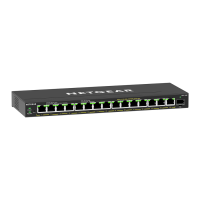The PoE+ power supplied by the switch is prioritized in ascending port order (from port
1 to port 15), with a total power budget of 180W (model GS316EP) or 231W (model
GS316EPP) across all active PoE+ ports.
The following table shows the standard power ranges, calculated with the maximum
cable length of 328 feet (100 meters). If a device receives insufficient PoE power from
the switch, consider using a shorter cable.
Table 5. PoE classes and PoE power allocations
Power Delivered to the
Device
Maximum Power
Supplied by the Switch
Class DescriptionCompatible PoE
Standard
Device
Class
0.44W–13.0W15.4WDefault power (full)PoE and PoE+0
0.44W–3.84W4.0WVery low powerPoE and PoE+1
3.84W–6.49W7.0WLow powerPoE and PoE+2
6.49W–13.0W15.4WMid powerPoE and PoE+3
13.0W–25.5W30.0WHigh powerPoE+4
Monitor PD health
You can use PD health monitoring to test the health of a powered device (PD) that is
connected to a PoE port. You can enable automated ping tests that check for connection
faults, and you can restart PoE power to the PD.
Note: Wait a few minutes after attaching the PD before you start the PD health monitor.
To display the status of the PD:
1.
Open a web browser from a computer that is connected to the same network as the
switch, or connected directly to the switch through an Ethernet cable.
2. Enter the IP address that is assigned to the switch.
A login window opens.
3. Enter the device management password.
The password is the one that you specified the first time that you logged in. The
password is case-sensitive.
The HOME page displays.
4. Select POE.
The Power over Ethernet (PoE) page displays.
User Manual93Maintain and Monitor the Switch
Gigabit Ethernet Plus Switches

